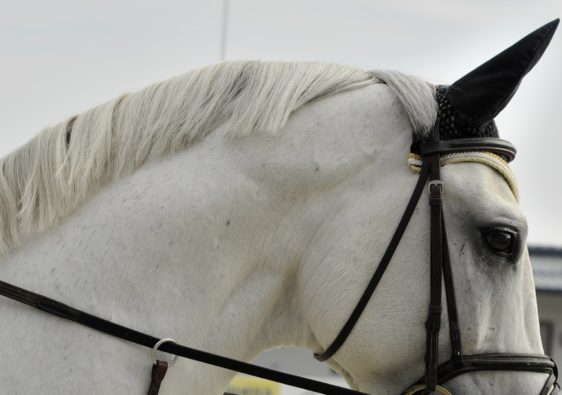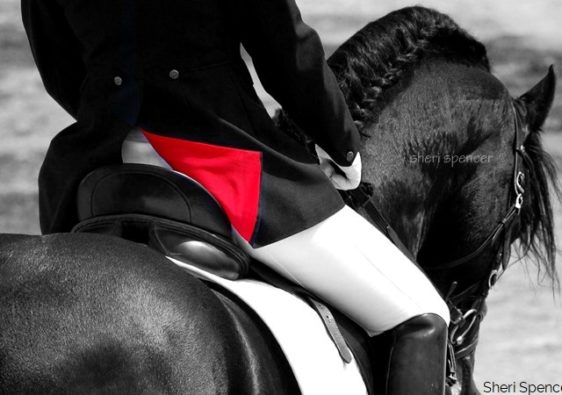There are few things as entrancing as watching a Grand Prix ride where the horse and rider seem to move as one. Cues are virtually imperceptible, even to a trained eye, and yet the horse’s motions are fluid and deliberate. While the technical skills are a journey in themselves, the foundation for the communication is attainable – and should be striven for – at all levels. Ride with your seat, and you will be empowered to take the focus from what you see in front of you to what you feel beneath you.
It is a perfectly natural (and common) habit for a rider to over-concern themselves with their hands – especially with steering – because, well, we use them all of the time for just about everything anyway and they’re right in front of us the whole time we ride (I should hope), but for clearer, kinder communication with our horses, we need to take that concentration and put it in our cores. Basically, put your brain in your belly.
I touched on this a fair bit in the first “Ride with Your Seat” post, so I’m going to take this a step further and emphasize a few basic turning techniques.
Steering with your Stomach
Imagine, if you will, that shining from your belly button is a beam of light. That beam of light is illuminating the path before you, and so you must “shine” that light in the direction you wish to go.
The metaphor is simple enough, and it really is in practice too.
The trick is by maintaining correct, upright posture so that you can have a comfortable amount of tension in your abdominal muscles. That tension is what stabilizes your core erect in the saddle, allowing your shoulders to relax squarely, elbows at your sides and neck straight.
(Depending on the movement, there will be some variation for specifics, and sometimes, you’ll notice, these things seem to contradict each other, but working on basic forward or longitudinal work, these are pretty reliable.)
To turn, you simply twist gently to “aim” your core (which I personally feel more stabilized to visualize it nestled at the top of my pelvis as opposed to where it gets all bendy in my waist) in your desired direction of travel, and while you want to keep your body in line and balanced, it is okay to let a few parts shift naturally. Those parts, to be more specific, include:
1) Your Outer Thigh:
Like the banked walls on a bobsled track, your outer thigh is essentially a guide – a “wall”, if you will – that provides a boundary against the horse’s ribs. Your outer thigh will help establish the outer boundary for your perimetre, and keep you, for example, from over-drifting your circle, or “support” the horse from the outside to make it around your jump course without losing your balance.
With the subtle twist of your core, your outer thigh will naturally displace itself slightly downwards and backwards, creating a subtle pressure – a “block” – on the ribs that will discourage movement in that direction.
2) Your Inner Calf, or Lower Leg
As your pelvis adjusts its position and your outer thigh shifts back, your inside leg will naturally drift slightly forwards, placing you calf nearer to the girth. Here, you can influence how much bend you get through the body, and are able to push the bend into the outer thigh, like pressing a pancake into a shallow bowl.
Between your inner calf and your outer thigh, you’ll be able to to experiment how much pressure is needed in order to maintain straightness.
That balance between your inside and outside leg aids will help you fine tune your half-halts, canter departures, and facilitate lifting of the horse’s back which is the gateway into collection.
3) Your Shoulders
Unlike your legs which tend to behave contradictorily to a twist in the core, your shoulders will follow suit as long as you keep your body tall and straight – which you should. (Obv.) So let your inside shoulder sweep back, while keeping it level with your outside shoulder. A common mistake is over-twisting and dropping that inside shoulder which then just sets the whole body into mishmash. Imagine, rather, that your spine is the stem of a flower, and your shoulders the petals, and let them gently rotate as needed to keep your core aimed in front of you and maybe even through your horse’s ears.
I think that’s enough to digest for one day… Hmm… What shall we talk about next in RWYS? Ooo maybe half-halts? They’re such a mysterious, elusive topic, those, and they are magical, I tell you.



